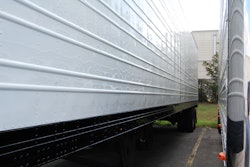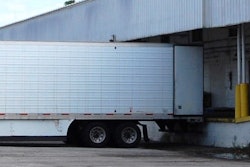As part of our Trucking's State of Surveillance special report last month examining the costs and/or benefits of increasingly ubiquitous communications technology since the 2017 electronic logging device mandate, a small number of readers reported improvement to the common shipper/receiver detention problem. Prior to the mandate, many in trucking felt increased load tracking capabilities enabled by more common use of ELDs might have a big impact on detention.
Yet just 15% of State of Surveillance survey respondents flagged improved load/unload times as a benefit of tracking.
 Download full survey results for larger view via this link.
Download full survey results for larger view via this link.
I was curious to know, though, how the detention issue had played out since the ELD mandate came into play, specifically. Asked that question directly with recent polling, readers overwhelmingly reported no significant improvement at their load/unload locations. Or, worse, that waits had only gotten longer and/or more frequent:
It's clear that the problem of excess detention remains. One independent commenting under the poll echoed the majority in noting that "shippers/receivers/brokers don't have a high concern level about this. If they're OK with you sitting out there and wasting a day, missing your next load because they kept you past the cutoff, and know there's no repercussions, why would they care about your DOT hours?"
The operator added a bit of apocrypha, too, that perhaps explains the entrenched nature of the problem: "About 80 years ago there was some good-natured driver somewhere that told the receiver, 'Sure I'll wait, no big deal!'" That good-natured driver didn't know just what he was starting.
Time is money, and commenter Richard Davis suggested the last Congress's unsuccessful move to pull employee truck drivers into the federal overtime-pay regulations under the Fair Labor Standards Act might go a long way toward better standardization of detention pay. Yet waiting on government is a losing game for any owner-operator or small fleet whose customers have a serious detention issue today.
One thing you can do to help matters today? Make the subject a standard part of your rate/contract negotiations on the front end.
You can use your own numbers to calculate a fair hourly rate to compensate for lost income opportunity as well as fixed costs, which don't stop when the truck stops, of course. Those two elements of a fair detention rate were deemed appropriate by most of Overdrive's audience almost a decade ago, when we used income, fixed cost and miles averages of owner-operator business services firm ATBS clients to compute an average $64/hour detention rate. I was reminded of that old computation just yesterday in conversation with an operator about how independents approach detention issues when dealing with brokers. As you might expect, owner-ops' time is worth considerably more today.
[Related: The 'extra load' to boost profitability in challenging times]
Using the same data points as before -- 60 mph for an average cruising speed, ATBS's 2022 income/cost/miles averages, presented in the Overdrive's Partners in Business seminar at MATS this past March -- I come to $82/hour for what time sitting should be worth to the average owner-operator among ATBS clientele. (Turns out that does just about a half-dollar or so better than the CPI inflation rate over the same 2015-'22 period.) Here's how I get there:
Annual income per mile: $64,300 / 85,000 miles = 76 cents/mile profit
+ Fixed costs per mile:: $52,000 / 85,000 miles = 61 cents/mile
= 1.37/mile
x 60 mph average cruising speed
= $82.20 / hour detention rate
Use your own numbers in place of these to better reflect what your own time detained ought to be worth. Some owners have in past suggested adding in the hourly cost to operate an auxiliary power unit to compensate for fuel used, if that's part of your set-up -- otherwise, the fuel cost to idle the rig might apply.
A simple conversation with any broker/shipper (your carrier if you're leased) about what you're putting in the rate -- a patient explanation of those fixed costs that must be covered, and the income lost sitting -- might yield results you don't expect, particularly if you're one among the many today in pursuit of more direct business. Negotiations over any contract that will lock you into a rate on a lane for a specific amount of time, particularly, strike me as great opportunities to engage the customer with your own numbers. That's true for owner-operators negotiating a pay package with a leasing carrier, too.
Many fleets offer their customers a two-hour or, increasingly, one-hour grace period before detention is charged, depending on the freight and the complexity of the load/unload environment. Communication with customers -- whether shipper or broker -- could get you to a reasonable solution.
Though I'll concede that the commenter quoted above is probably exactly right and, indeed, shippers/receivers/brokers don't have a high concern level about this, it's also true that money has a way of motivating any business. You can't know the result unless you try.
[Related: 'Demand detention' pay: Strong voices on compensation for waits]










